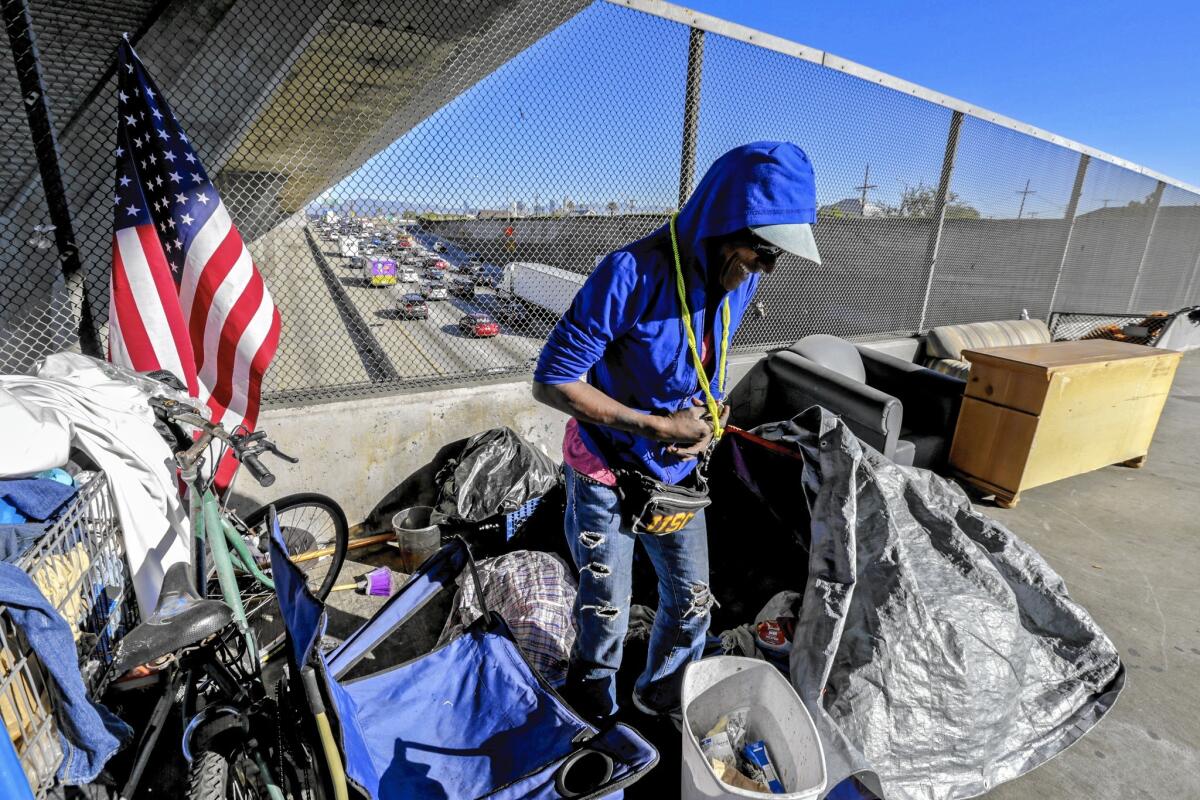With El Niño looming, L.A. has little to show in city’s ‘war on homelessness’

No problem has prompted more urgent rhetoric at Los Angeles City Hall this fall than the plight of those who live and sleep unsheltered on L.A.’s streets.
In July, Mayor Eric Garcetti announced during a speech on downtown’s skid row that his staff was a month away from completing a “battle plan” for the “war on homelessness.” City Council members drew headlines from around the world in September when they held a news conference publicizing their intention to formally “declare the homeless crisis an emergency,” in the words of Council President Herb Wesson.
But as the year’s end approaches, city officials have little to show for such announcements. The mayor’s promised “battle plan” has been quietly scaled back to a loose framework of strategies for reducing homelessness. Two weeks ago, the prospect of a formal emergency declaration receded, as the mayor and some council members asserted the move may not be necessary.
Elected leaders say they are opting for a path of steady, methodical progress on a problem that has long proved resistant to government’s best intentions. Yet critics say the lack of follow-through on repeated vows of prompt action has sent a troubling signal about the seriousness and competence of City Hall’s fight against homelessness.
“Everyone looks bad because of this,” said Jaime Regalado, an emeritus professor of political science at Cal State L.A. “It looks like we’re back to Square One for many, many people. The results aren’t happening. It looks like the actions toward results aren’t happening. Words are cheap.”
About 26,000 men, women and children are homeless in Los Angeles, 18,000 of them without shelter of any kind. That makes L.A.’s unsheltered homeless population the nation’s largest — more than five times that of New York City, which has greater overall numbers of homeless people but manages to place most in short-term shelters.
There is broad consensus among public officials and private-sector advocates that a safety net consisting of long-term housing and social services is the most effective approach to the problem. Representatives of the city, county and nonprofit sector have begun meeting regularly to create a plan for building such a system, a level of coordination that some hail as a breakthrough for agencies that have historically been prone to mutual finger-pointing when it comes to homelessness.
But that plan isn’t expected to be ready until at least January. Between now and then, some say the homelessness count will continue to rise, with dangers for those living on the streets exacerbated by the severe El Niño storms forecast for this winter.
“I think there is less of a sense of urgency, certainly,” said Carol Sobel, a Santa Monica civil-rights attorney who has successfully sued the city over its past treatment of the homeless. “We’re all waiting for this plan that they’re going to come out with in January. And then El Niño will be over and they’ll decide it isn’t urgent anymore.”
City officials strongly dispute suggestions that their zeal to tackle homelessness has slackened. Rick Coca, a spokesman for Councilman Jose Huizar, said the council has moved to create a more accountable hierarchy for helping the homeless, establishing its first ever committee on homelessness and voting to hire a citywide homeless services coordinator. (The mayor’s office already has its own homelessness policy director, former housing attorney Greg Spiegel.)
Huizar — whose district includes the city’s most intense concentration of the homeless on skid row and who co-chairs the council’s homelessness committee — plans to introduce a motion this week that will funnel roughly $13 million to placing people on the streets in short-term shelters and offering “rapid rehousing” for those who recently lost their homes. Those funds were earmarked by the mayor in September for immediate action on homelessness.
“We’ve been diligently doing the work. Ultimately, that is what we will be judged on,” Coca said.
Garcetti, for his part, has not released the detailed “battle plan” against homelessness he alluded to over the summer. The mayor has opted instead for articulating broad goals and principles his staff says will influence the comprehensive city-county plan due out next year. Among them are the prevention of homelessness through more jobs and better wages and the use of outreach workers to connect people living on the streets with appropriate housing and social services.
Mayoral spokeswoman Connie Llanos said in a statement that Garcetti is aware of the threats that winter rains and floods pose to the homeless and is “aggressively pursuing every tool, including actively engaging our state and federal partners, to help save lives with El Niño on the horizon.” She said the mayor has not ruled out declaring a state of emergency in the future.
“We are open to anything that will help bring us additional resources to this crisis,” Llanos said.
Questions persist about the benefits that would accompany a formal emergency declaration. Some special powers — such as the ability to house the homeless in public buildings and to bypass some housing and safety regulations in order to find people shelter — can already be invoked under the shelter crisis the city routinely declares each winter.
Portland’s declaration of a homelessness emergency in October was in some ways more important for the message it sent than its legal consequences, said Josh Alpert, chief of staff for Portland, Ore., Mayor Charlie Hales.
“Symbolically, it’s opening up a lot more doors. It’s gotten a lot of media attention,” Alpert said. “I’ve never seen this outpouring of support and efforts to volunteer.... The message has gotten out there.”
Ironically, it is L.A. officials’ efforts to similarly galvanize public opinion that may have invited some of the impatience they now face.
Zev Yaroslavsky, a former county supervisor and city councilman with a long history of involvement in homelessness policy, said the charged rhetoric of battle plans and emergency declarations emanating from City Hall in recent months may have led Angelenos to mistakenly conclude that homelessness could be solved quickly.
“When the declaration of emergency came out, it raised the public expectations to a level that was unachievable,” Yaroslavsky said. “Then the government has a credibility gap.”
Yaroslavsky said he believes that the mayor and council members have a genuine sense of urgency about the city’s surging homelessness, and are taking meaningful steps forward. He praised in particular new City Hall efforts to coordinate with the county and private sector.
However, he said those actions should be understood as part of a years-long struggle in which victories will be incremental.
“I don’t see the light at the end of the tunnel on homelessness,” he said. “This is going to be Afghanistan. It’s not going to be World War II.”
ALSO
California’s top court sends Newhall Ranch project back to the drawing board
Ex-L.A. County sheriff’s deputies sentenced to prison for beating of jail visitor
Hundreds bid goodbye at funeral for slain Downey police officer
More to Read
Start your day right
Sign up for Essential California for news, features and recommendations from the L.A. Times and beyond in your inbox six days a week.
You may occasionally receive promotional content from the Los Angeles Times.







